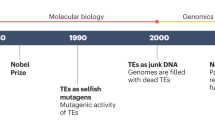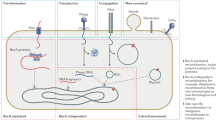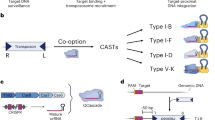Key Points
-
Transposons — a class of mobile genetic elements — are widespread in nature, being present in virtually every organism that has been examined. The bacterial transposon Tn7 is of particular interest because of its ability to use several different kinds of target sites. The highly evolved target-site selection pathways of Tn7 aid its dispersal among bacterial populations by directing insertions onto plasmids yet discourage any potentially harmful random insertions into bacterial chromosomes.
-
The Tn7 proteins TnsA, TnsB, and TnsC make up the core machinery for Tn7 transposition. TnsA and TnsB collaborate to form the transposase. TnsC is a regulator of transposase activity, communicating between the TnsAB transposase and the alternative target-site selecting proteins, TnsD and TnsE.
-
When the TnsE protein is utilized with the core TnsABC machinery, Tn7 preferentially directs insertions into conjugable plasmids, which can move between cells. Interaction between TnsE and a structure that is associated with lagging-strand DNA replication is probably crucial for target recognition in this pathway.
-
When the TnsD protein is utilized with the core machinery, insertions are directed into a single site in the bacterial chromosome, called attTn7. This site is highly conserved among bacterial chromosomes. TnsD specifically recognizes attTn7 and induces a distortion at the 5′ end of the binding site that is probably crucial in recruiting TnsC. Footprinting results indicate that TnsC could form a platform below the target DNA to receive and activate the TnsAB transposase to carry out recombination.
-
TnsC acts as a regulator of Tn7 transposition by its ability to interact both with the TnsAB transposase and the with target DNA that is bound by TnsD or TnsE. TnsC is also responsible for transposon immunity, a process that hinders insertions from occurring into a target DNA when a copy of Tn7 already resides in that DNA. TnsC might use a mechanism similar to the Ras molecular switch to balance the various "ON" and "OFF" signals that control transposition.
-
Future research with Tn7 should provide further insight into how multiprotein machines are assembled on DNA in replication, repair, and recombination.
Abstract
A notable feature of transposable elements — segments of DNA that can move from one position to another in genomes — is that they are highly prevalent, despite the fact that their translocation can result in mutation. The bacterial transposon Tn7 uses an elaborate system of target-site selection pathways that favours the dispersal of Tn7 in diverse hosts as well as minimizing its negative effects.
This is a preview of subscription content, access via your institution
Access options
Subscribe to this journal
Receive 12 print issues and online access
$189.00 per year
only $15.75 per issue
Buy this article
- Purchase on Springer Link
- Instant access to full article PDF
Prices may be subject to local taxes which are calculated during checkout







Similar content being viewed by others
References
Lander, E. S. et al. Initial sequencing and analysis of the human genome. Nature 409, 860–921 (2001).
Venter, J. C. et al. The sequence of the human genome. Science 291, 1304–1351 (2001).
Craig, N. L. Target site selection in transposition. Annu. Rev. Biochem. 66, 437–474 (1997).
Craig, N. L. Transposon Tn7. Curr. Top. Microbiol. Immunol. 204, 27–48 (1996).
Hall, R. M., Brookes, D. E. & Stokes, H. W. Site-specific insertion of genes into integrons: role of the 59-base element and determination of the recombination cross-over point. Mol. Microbiol. 5, 1941–1959 (1991).
Hauer, B. & Shapiro, J. A. Control of Tn7 transposition. Mol. Gen. Genet. 194, 149–158 (1984).
Rogers, M., Ekaterinaki, N., Nimmo, E. & Sherratt, D. Analysis of Tn7 transposition. Mol. Gen. Genet. 205, 550–556 (1986).
Waddell, C. S. & Craig, N. L. Tn7 transposition: two transposition pathways directed by five Tn7-encoded genes. Genes Dev. 2, 137–149 (1988).
Sarnovsky, R., May, E. W. & Craig, N. L. The Tn7 transposase is a heteromeric complex in which DNA breakage and joining activities are distributed between different gene products. EMBO J. 15, 6348–6361 (1996).Together with reference 20 , this study provided the first evidence that the Tn7 transposase was heteromeric.
Biery, M., Lopata, M. & Craig, N. L. A minimal system for Tn7 transposition: the transposon-encoded proteins TnsA and TnsB can execute DNA breakage and joining reactions that generate circularized Tn7 species. J. Mol. Biol. 297, 25–37 (2000).
Lu, F. & Craig, N. L. Isolation and characterization of Tn7 transposase gain-of-function mutants: a model for transposase activation. EMBO J. 19, 3446–3457 (2000).
Mizuuchi, K. Transpositional recombination: mechanistic insights from studies of Mu and other elements. Annu. Rev. Biochem. 61, 1011–1051 (1992).
Haren, L., Ton-Hoang, B. & Chandler, M. Integrating DNA: transposases and retroviral integrases. Annu. Rev. Microbiol. 53, 245–281 (1999).
Dyda, F. et al. Crystal structure of the catalytic domain of HIV-1 integrase: similarity to other polynucleotidyl transferases. Science 266, 1981–1986 (1994).
Rice, P. & Mizuuchi, K. Structure of the bacteriophage Mu transposase core: a common structural motif for DNA transposition and retroviral integration. Cell 82, 209–220 (1995).
Davies, D. R., Braam, L. M., Reznikoff, W. S. & Rayment, I. The three-dimensional structure of a Tn5 transposase-related protein determined to 2.9-Å resolution. J. Biol. Chem. 274, 11904–11913 (1999).
Reznikoff, W. S. The Tn5 transposon. Annu. Rev. Microbiol. 47, 945–963 (1993).
Kleckner, N., Chalmers, R., Kwon, D., Sakai, J. & Bolland, S. Tn10 and IS10 transposition and chromosome rearrangements: mechanism and regulation in vivo and in vitro. Curr. Top. Microbiol. Immunol. 204, 49–82 (1996).
Arciszewska, L. K., Drake, D. & Craig, N. L. Transposon Tn7 cis-acting sequences in transposition and transposition immunity. J. Mol. Biol. 207, 35–52 (1989).
May, E. W. & Craig, N. L. Switching from cut-and-paste to replicative Tn7 transposition. Science 272, 401–404 (1996).
Hickman, A. B. et al. Unexpected structural diversity in DNA recombination: the restriction endonuclease connection. Mol. Cell 5, 1025–1034 (2000).The structure of TnsA shows that one of the proteins of the heteromeric Tn7 transposase is actually a restriction enzyme that is used for transposition.
Bainton, R. J., Kubo, K. M., Feng, J.-N. & Craig, N. L. Tn7 transposition: target DNA recognition is mediated by multiple Tn7-encoded proteins in a purified in vitro system. Cell 72, 931–943 (1993).This study provides the first description of the complete TnsABC+D in vitro transposition reaction from purified proteins.
Stellwagen, A. E. Analysis of gain of function mutants of an ATP-dependent regulator of Tn7 transposition. J. Mol. Biol. 305, 633–642 (2001).
Stellwagen, A. & Craig, N. L. Gain-of-function mutations in TnsC, an ATP-dependent transposition protein which activates the bacterial transposon Tn7. Genetics 145, 573–585 (1997).
Wolkow, C. A., DeBoy, R. T. & Craig, N. L. Conjugating plasmids are preferred targets for Tn7. Genes Dev. 10, 2145–2157 (1996).
Barth, P. & Grinter, N. Map of plasmid RP4 derived by insertion of transposon C. J. Mol. Biol. 113, 455–474 (1977).
Peters, J. E. & Craig, N. L. Tn7 recognizes target structures associated with DNA replication using the DNA binding protein TnsE. Genes Dev. 15, 737–747 (2001).Together with reference 28 , this study showed that TnsE-mediated transposition recognizes structures associated with DNA replication.
Peters, J. E. & Craig, N. L. Tn7 transposes proximal to DNA double-strand breaks and into regions where chromosomal DNA replication terminates. Mol. Cell 6, 573–582 (2000).
Cox, M. M. et al. The importance of repairing stalled replication forks. Nature 404, 37–41 (2000).
Gay, N. J., Tybulewica, V. L. J. & Walker, J. E. Insertion of transposon Tn7 into the Escherichia coli glmS transcriptional terminator. Biochem. J. 234, 111–117 (1986).
Lichtenstein, C. & Brenner, S. Unique insertion site of Tn7 in E. coli chromosome. Nature 297, 601–603 (1982).
Walker, J. E., Gay, N. J., Saraste, M. & Eberle, A. N. DNA sequence around the Escherichia coli unc operon. Completion of the sequence of a 17 kilobase segment containing asnA, oriC, unc, glmS and phoS. Biochem. J. 224, 799–815 (1984).
Gringauz, E., Orle, K., Orle, A., Waddell, C. S. & Craig, N. L. Recognition of Escherichia coli attTn7 by transposon Tn7: lack of specific sequence requirements at the point of Tn7 insertion. J. Bacteriol. 170, 2832–2840 (1988).
Cleaver, S. H. & Wickstrom, E. Transposon Tn7 gene insertion into an evolutionarily conserved human homolog of Escherichia coli attTn7. Gene 254, 37–44 (2000).
Bainton, R., Gamas, P. & Craig, N. L. Tn7 transposition in vitro proceeds through an excised transposon intermediate generated by staggered breaks in DNA. Cell 65, 805–816 (1991).
Rao, J. E., Miller, P. S. & Craig, N. L. Recognition of triple-helical DNA structures by transposon Tn7. Proc. Natl Acad. Sci. USA 97, 3936–3941 (2000).
Kuduvalli, P., Rao, J. & Craig, N. L. Target DNA structure plays a critical role in Tn7 transposition. EMBO J. 20, 1–10 (2001).Together with reference 36 , this study shows that an induced DNA structure is of key importance in recruiting TnsC and the core transposition machinery.
Pryciak, P. M. & Varmus, H. E. Nucleosomes, DNA-binding proteins, and DNA sequence modulate retroviral integration target site selection. Cell 69, 769–780 (1992).
Katz, R. A., Gravuer, K. & Skalka, A. M. A preferred target DNA structure for retroviral integrase in vitro. J. Biol. Chem. 273, 24190–24195 (1998).
Rao, J. E. & Craig, N. L. Selective recognition of pyrimidine motif triplexes by a protein encoded by the bacterial transposon Tn7. J. Mol. Biol. 307, 1161–1170 (2001).
Sharpe, P. & Craig, N. L. Host proteins can stimulate Tn7 transposition: a novel role for the ribosomal protein L29 and the acyl carrier protein. EMBO J. 17, 5822–5831 (1998).
Gamas, P. & Craig, N. L. Purification and characterization of TnsC, a Tn7 transposition protein that binds ATP and DNA. Nucleic Acids Res. 20, 2525–2532 (1992).
Oppon, J. C., Sarnovsky, R. J., Craig, N. L. & Rawlings, D. E. A Tn7-like transposon is present in the glmUS region of the obligately hemoautolithotrophic bacterium Thiobacillus ferrooxidans. J. Bacteriol. 180, 3007–3012 (1998).
Lee, C.-H., Bhagwhat, A. & Heffron, F. Identification of a transposon Tn3 sequence required for transposition immunity. Proc. Natl Acad. Sci. USA 80, 6765–6769 (1983).
Adzuma, K. & Mizuuchi, K. Interaction of proteins located at a distance along DNA: mechanism of target immunity in the Mu DNA strand-transfer reaction. Cell 57, 41–47 (1989).
Reyes, I., Beyou, A., Mignotte-Vieux, C. & Richaud, F. Mini-Mu transduction: cis-inhibition of the insertion of Mud transposons. Plasmid 18, 183–192 (1987).
DeBoy, R. & Craig, N. L. Tn7 transposition as a probe of cis interactions between widely separated (190 kilobases apart) DNA sites in the Escherichia coli chromosome. J. Bacteriol. 178, 6184–6191 (1996).
Stellwagen, A. & Craig, N. L. Avoiding self: two Tn7-encoded proteins mediate target immunity in Tn7 transposition. EMBO J. 16, 6823–6834 (1997).
Bourne, H. R., Sanders, D. A. & McCormick, F. The GTPase superfamily: a conserved switch for diverse cell functions. Nature 348, 125–132 (1990).
Maxwell, A., Craigie, R. & Mizuuchi, K. B protein of bacteriophage Mu is an ATPase that preferentially stimulates intermolecular DNA strand transfer. Proc. Natl Acad. Sci. USA 84, 699–703 (1987).
Baker, T. A., Mizuuchi, M. & Mizuuchi, K. MuB protein allosterically activates strand transfer by the transposase of phage Mu. Cell 65, 1003–1013 (1991).
Surette, M. G. & Chaconas, G. Stimulation of the Mu DNA strand cleavage and intramolecular strand transfer reactions by the MuB protein is independent of stable binding of the MuB protein to DNA. J. Biol. Chem. 266, 17306–17313 (1991).
Stellwagen, A. & Craig, N. L. Mobile DNA elements: controlling transposition with ATP-dependent molecular switches. Trends Biochem. Sci. 23, 486–490 (1998).
Lowy, D. R. & Willumsen, B. M. Function and regulation of Ras. Annu. Rev. Biochem. 62, 851–891 (1993).
Sprang, S. R. G protein mechanisms: insights from structural analysis. Annu. Rev. Biochem. 66, 639–678 (1997).
Acknowledgements
We thank Z. Skelding and P. Kudavalli for comments and suggestions on the manuscript. The Howard Hughes Medical Institute, the National Institutes of Health and the National Science Foundation supported this work.
Author information
Authors and Affiliations
Corresponding author
Glossary
- REPLICON
-
A contiguous DNA segment with an origin(s) of DNA replication.
- CONJUGAL PLASMIDS
-
A class of autonomously replicating circular DNA that can move between bacteria.
- ORIGIN OF TRANSFER
-
A cis-acting DNA site found in conjugal plasmids that is recognized by the transfer proteins and at which DNA transfer initiates.
- DISCONTINUOUS OR LAGGING-STRAND DNA SYNTHESIS
-
DNA replication that must continually be re-primed approximately every two kilobase pairs in bacteria.
- ORIGIN OF BI-DIRECTIONAL DNA REPLICATION
-
The site at which the DNA strands are melted and the replisome is assembled for DNA replication, which progresses in the 3′ and 5′ directions and replicates both strands.
- attTn7
-
A DNA sequence that is found in the highly conserved carboxy-terminal coding region of the glutamine synthetase (glmS) gene in bacteria and is recognized by the Tn7 protein, TnsD.
- TRIPLEX DNA
-
A DNA structure in which a third DNA strand docks in the major groove of duplex DNA using atypical Hoogsteen hydrogen bonding.
Rights and permissions
About this article
Cite this article
Peters, J., Craig, N. Tn7: smarter than we thought. Nat Rev Mol Cell Biol 2, 806–814 (2001). https://doi.org/10.1038/35099006
Issue Date:
DOI: https://doi.org/10.1038/35099006
This article is cited by
-
Chromosomal barcodes for simultaneous tracking of near-isogenic bacterial strains in plant microbiota
Nature Microbiology (2024)
-
Salmonella Typhimurium expressing chromosomally integrated Schistosoma mansoni Cathepsin B protects against schistosomiasis in mice
npj Vaccines (2023)
-
From parasites to partners: exploring the intricacies of host-transposon dynamics and coevolution
Functional & Integrative Genomics (2023)
-
VIM-encoding IncpSTY plasmids and chromosome-borne integrative and mobilizable elements (IMEs) and integrative and conjugative elements (ICEs) in Pseudomonas
Annals of Clinical Microbiology and Antimicrobials (2022)
-
Creation of Golden Gate constructs for gene doctoring
BMC Biotechnology (2020)



